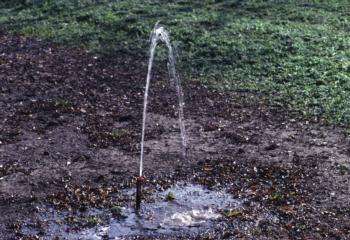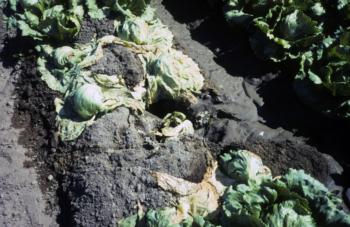University of California
Maintenance of Microirrigation Systems
Leaks

Microsprinkler with missing head Photo: L. Schwankl.
In orchards and vineyards, it is not uncommon to inspect the microirrigation system at each irrigation, often using a four-wheeler ATV or other motorized vehicle. Leaks in row and field crops are more difficult to detect, especially where the plant canopy has closed over. Unfortunately, under such conditions some leaks are not detected until water starts to accumulate at the end of the field, or until someone walks through and inspects the field. "Finding" the leak with machinery working the field is not recommended.
Leak detection in subsurface drip irrigation (SDI) systems is a great challenge. Leaks in permanent crop SDI systems, with their more open ground area, are often visually detectable, but fixing those leaks can be a challenge because the drip tubing or tape is often installed deeper, sometimes as deep as 24 inches.

Result of a leak caused by a gopher in a lettuce field. Photo: L. Schwankl.
For those SDI systems where the tail ends of the lateral lines are left exposed, you can detect leaks by opening the ends of the lines, a few at a time, just as you do when flushing the lines. Lateral lines with leaks will have greatly diminished flow, or no flow at all when you open the lines. Then you can walk those suspect lines to inspect them for leaks.
Dealing with leaks in a microirrigation system requires frequent inspections to detect and repair them. Microirrigation systems are not low-maintenance or low-labor systems. They need constant attention if they are to operate at optimum performance.
